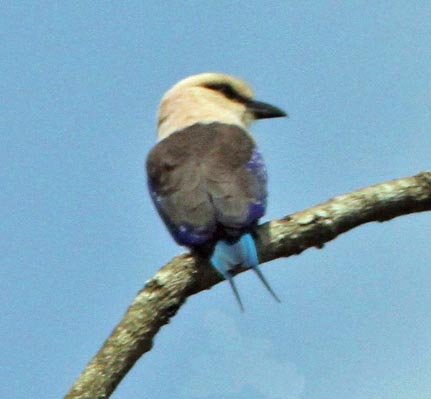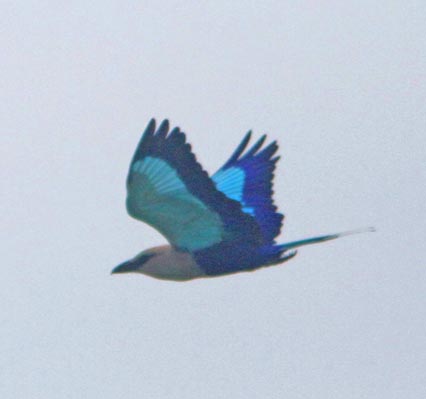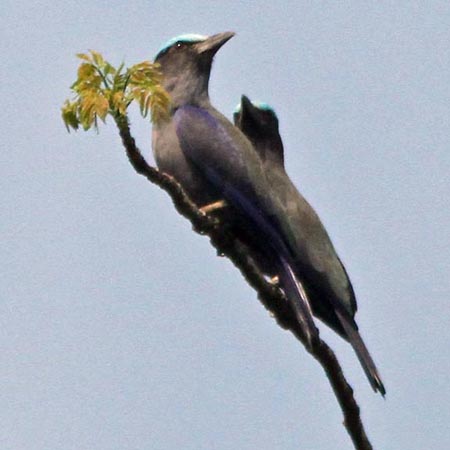
a web page by Don Roberson |
ROLLERS Coraciidae |
||
|
||
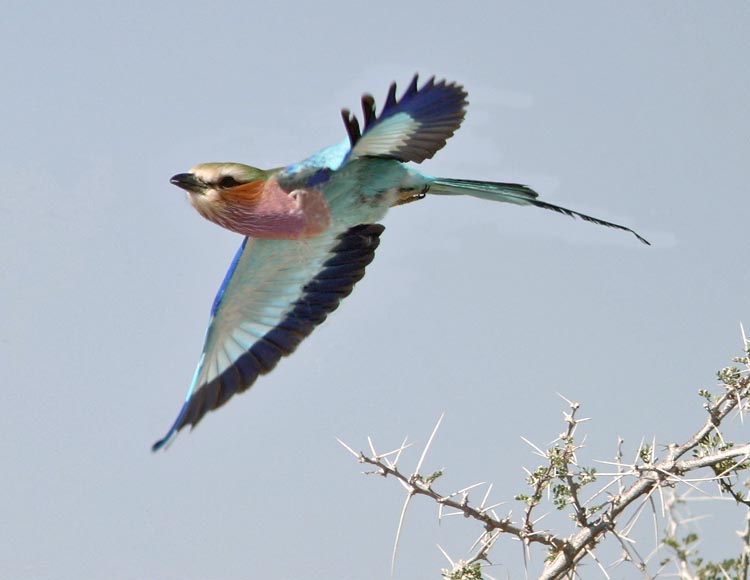 Rollers
are often gaudy and conspicuous birds of open country. Their family
name comes from dramatic, noisy, rolling flight displays used both in
pair-bonding and in territorial defense. Although often
brightly-colored when perched, their most vivid patterns are concealed
within the close wing under they take flight — these sudden flashes of
blue and azure are startling and spectacular. Lilac-breasted Roller (left,
in flight, and below left, perched) is one of the most lovely birds of
the east and south African thornscrub or grassy savanna. Yet, if
anything, the shocking wing pattern of Indian Roller (below right) from south Asia is even more impressive. Rollers
are often gaudy and conspicuous birds of open country. Their family
name comes from dramatic, noisy, rolling flight displays used both in
pair-bonding and in territorial defense. Although often
brightly-colored when perched, their most vivid patterns are concealed
within the close wing under they take flight — these sudden flashes of
blue and azure are startling and spectacular. Lilac-breasted Roller (left,
in flight, and below left, perched) is one of the most lovely birds of
the east and south African thornscrub or grassy savanna. Yet, if
anything, the shocking wing pattern of Indian Roller (below right) from south Asia is even more impressive. |
||
|
||
There some exceptions to these generalizations, such as the forest species [Dollarbird Eurystomus orientalis in Asia, or Broad-billed Roller E. glaucurus in Africa and Madagascar]. These "hunt on the wing, taking a large variety of beetles, bugs, crickets and wasps captured in powerful, falcon-like flight as the birds wheel, swoop and dash around the treetops." The only roller known to eat any vegetable matter, says Fry et al. (1992), is the Blue-bellied Roller of west Africa (below), which will "sometimes eat oil-palm fruits." |
||
|
||
Eight of the world's dozen rollers are assigned to genus Coracias, including all those preceding this section and the endemic Purple-winged Roller (left) of Sulawesi in Indonesia. This resident species is found primarily in pairs. Some of the Coracias rollers are migratory. Eurasian Roller C. garrulus breeds in east and southern Europe in the northern summer, and then migrates to sub-Saharan Africa for the winter. Some African species — such as Abyssinian Roller C. abyssinicus and Rufous-crowned Roller C. naevius — are intra-continental migrants, moving away from the equator (north or south) in the breeding season, and back towards the tropical equatorial belt after breeding. The remaining four rollers are forest rollers in genus Eurystomus, two in Africa and two in tropical Asia. Blue-throated Roller E. gularis is found in west and central Africa. The more widespread African bird is Broad-billed Roller (below, a photo from Madagascar). Its range extends from the Sahel to Madagascar in the breeding season, but pretty much concentrates in the equatorial forest belt in the non-breeding season. The 'breeding season' varies from place to place, dependent on rains (among other things). Monogamous pairs defend treetop territories with much calling and aerial chasing (Fry 2001b). |
||
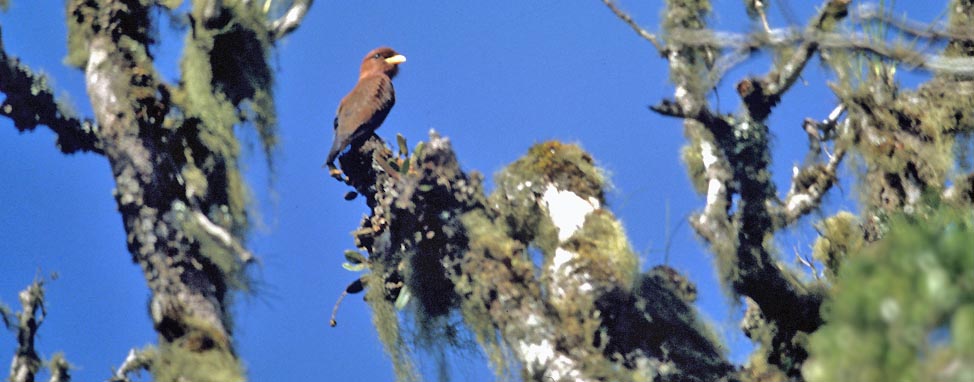 |
||
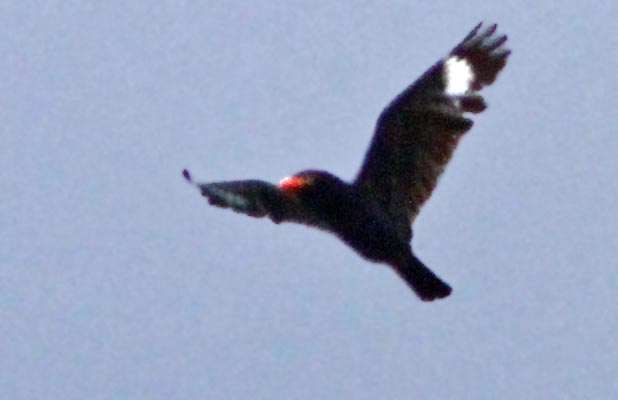 Probably the least known and rarest roller is Azure Roller
(right) from Halmahera and a few adjacent islands in the north
Moluccas, Indonesia. It is threatened by loss of forest habitat. Almost
nothing is known of its natural history (Fry 2001b). It was once
considered a race of Dollarbird – both have big red bills — but it now
split by all major checklists. It has been variously called "Azure
Dollarbird," "Purple Dollarbird," or "Purple Roller" in the past, but
these are all very poor English names. Modifying "Dollarbird" for this
bird (by adding "Purple" or "Azure") would require adding a modifier to
the long-established name "Dollarbird" for E. orientalis, for no good
purpose whatsoever. "Purple Roller" is an alternative name of
Rufous-crowned Roller in Africa, so is a terrible choice for this very
localized endemic. Azure Roller is a very fine name for a superb and
rare bird. Probably the least known and rarest roller is Azure Roller
(right) from Halmahera and a few adjacent islands in the north
Moluccas, Indonesia. It is threatened by loss of forest habitat. Almost
nothing is known of its natural history (Fry 2001b). It was once
considered a race of Dollarbird – both have big red bills — but it now
split by all major checklists. It has been variously called "Azure
Dollarbird," "Purple Dollarbird," or "Purple Roller" in the past, but
these are all very poor English names. Modifying "Dollarbird" for this
bird (by adding "Purple" or "Azure") would require adding a modifier to
the long-established name "Dollarbird" for E. orientalis, for no good
purpose whatsoever. "Purple Roller" is an alternative name of
Rufous-crowned Roller in Africa, so is a terrible choice for this very
localized endemic. Azure Roller is a very fine name for a superb and
rare bird. |
||
Photos: The flying Lilac-breasted Roller Coracias caudatus was at Etosha NP, Namibia, in July 2005; the perched one was at Ndutu, Tanzania, in March 2002. The wing-spreading Indian Roller C. benghalensis was at Bharatpur, India, in March 2001. The Rufous-crowned Roller C. naevius was in Kruger NP, South Africa, in July 1996. The perched Blue-bellied Roller C. cyanogaster was Opra Forest, Ghana, on 11 Dec 2013; the flying one was in Shimba Hills Reserve, Ghana, on 28 Nov 2013. The pair of Purple-winged Roller C. temminckii was at Dumogo-Bone NP, Sulawesi, on 3 Oct 2011.The Broad-billed Roller Eurystomus glaucurus was at Perinet Reserve, Madagascar, on 2 Dec 1992. The in-flight Azure Roller E. azureus was in selectively logged forest near Foli, Halmahera, Indonesia, on 8 Oct 2011. Photos © Don Roberson; all rights reserved. Family book:
Literature cited:
|
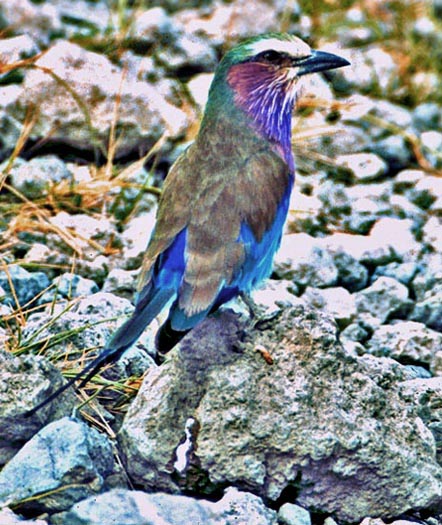
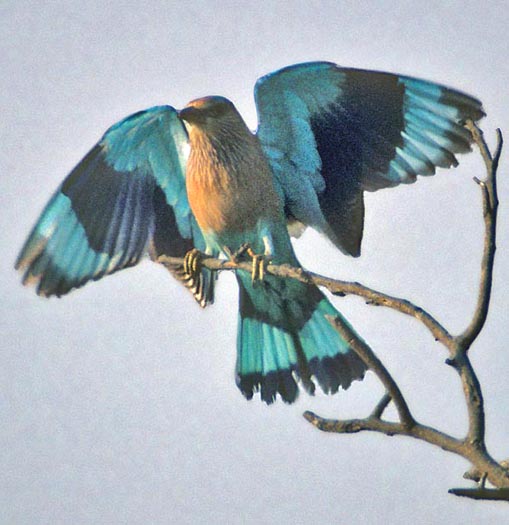
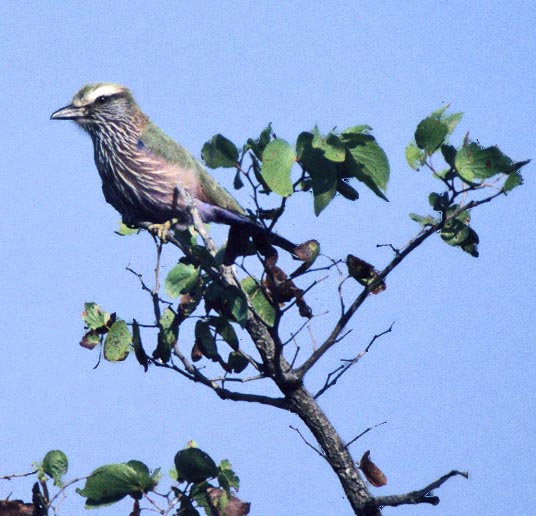 Rollers,
says Fry et al. (1992), are "sit-and-wait predators hunters (often)
keeping watch from any elevated station — tree, lamp post, fence or
building — and sailing down to land by the prey, which is grabbed in
the bill and dismembered and eaten back at the perch. A characteristic
of their diets is the inclusion of noxious prey that other birds
generally leave alone, such as hairy caterpillars and warningly
coloured grasshoppers, and rollers often eat scorpions, centipede and
small snakes. They will, in fact, eat practically all invertebrates
encountered on the ground, including maggots, spiders, ants, wasps,
worms, molluscs and mantises, and a wide range of vertebrates, too:
lizards, toads, shrews, rodents and young birds. Rollers forage well
into dusk, and sometimes feed at night near street lights." For these
purposes, rollers have powerful hooked bills, such as that shown by
this Rufous-crowned Roller (right).
Rollers,
says Fry et al. (1992), are "sit-and-wait predators hunters (often)
keeping watch from any elevated station — tree, lamp post, fence or
building — and sailing down to land by the prey, which is grabbed in
the bill and dismembered and eaten back at the perch. A characteristic
of their diets is the inclusion of noxious prey that other birds
generally leave alone, such as hairy caterpillars and warningly
coloured grasshoppers, and rollers often eat scorpions, centipede and
small snakes. They will, in fact, eat practically all invertebrates
encountered on the ground, including maggots, spiders, ants, wasps,
worms, molluscs and mantises, and a wide range of vertebrates, too:
lizards, toads, shrews, rodents and young birds. Rollers forage well
into dusk, and sometimes feed at night near street lights." For these
purposes, rollers have powerful hooked bills, such as that shown by
this Rufous-crowned Roller (right). 